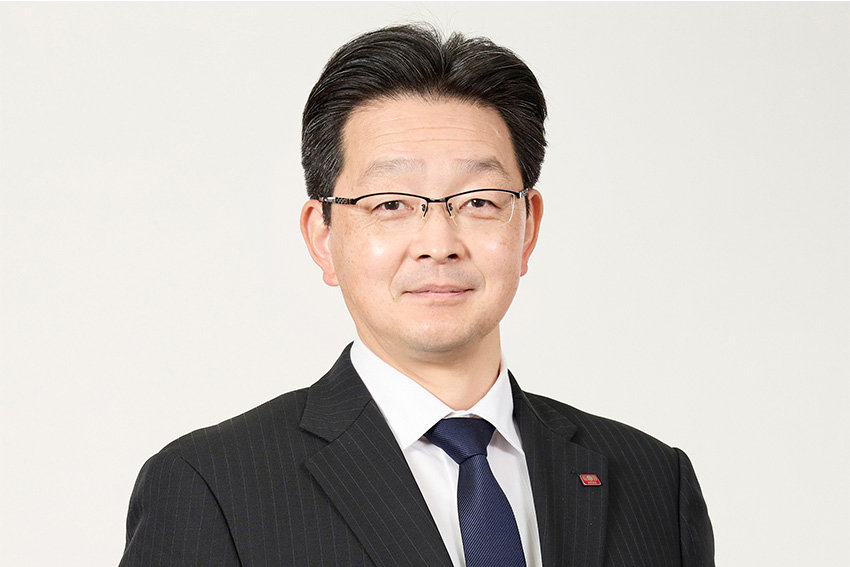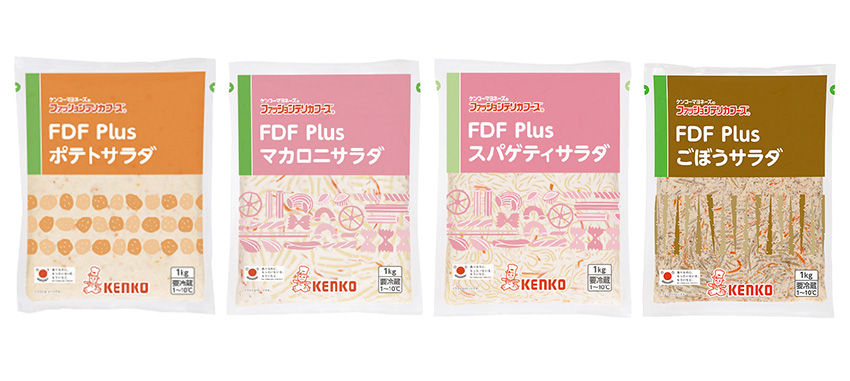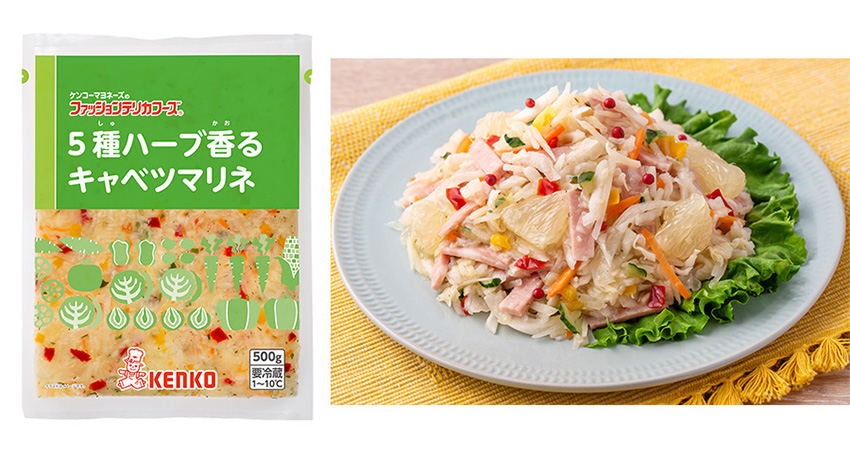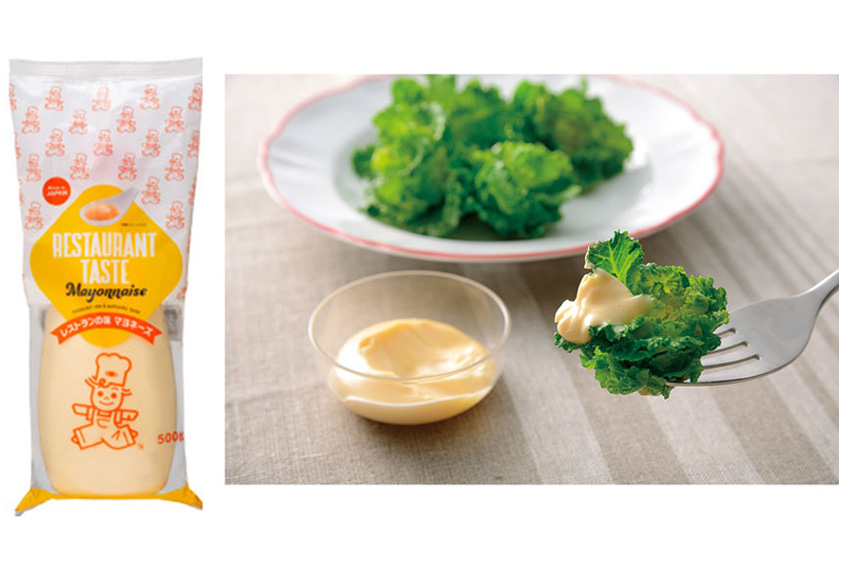Utilizing a track record of know-how, Kenko Mayonnaise will spread SALAD RYORI worldwide.

Japanese food exports have been rising each year for the last decade, reaching JPY 1.45 trillion last year. With this sort of growth, the government is aiming to push this even higher. In fact, they’ve set a target of JPY 5 trillion by 2030 by increasing human resource capabilities and the marketing of Japanese products abroad. How do you account for these record levels of Japanese food exports, and what steps do you think need to be taken to achieve this target by the end of the decade?
There is a correlation between the rising interest in washoku (Japanese cuisine) globally and the increasing inbound tourism. At the same time, people better understand and appreciate the unique and delicious taste, quality of ingredients, freshness, and safety of Japanese cuisine. Another factor is that in 2013, washoku was designated as a UNESCO intangible cultural heritage, gaining global recognition. Yet another factor is that many Japanese chain restaurants have recently opened overseas operations, making not only sushi but also tempura, ramen, udon, curry rice, wagyu, and other authentic Japanese foods accessible overseas, thus increasing their popularity.
To achieve this JPY 5 trillion target for overseas exports, increasing the diversity of the products to export will be necessary. In the long term, the growth of washoku will be more prevalent, and JPY 5 trillion is an achievable target. Our company primarily exports mayonnaise, dressings, and sauces, but we aim to expand our range of products for overseas export. Two issues to consider are the complexity of import and export customs, as well as the differing local regulations on labeling, so government support in these areas would help be a driving force for Japanese companies to go abroad.
One challenge that Japan is facing is demographic change, especially a declining population. This is creating a dual problem; a declining domestic market and difficulties in hiring staff. In fact, it’s estimated that by 2040, Japan will face a shortage of over 10 million workers. This pushes some companies to look abroad or automate operations. How is your company reacting to this decline and trying to implement automation to tackle the shortage of workers?
We are being affected by the staffing shortage. Specifically, we heavily rely on manual labor for plating deli and salad products for supermarkets. This plating is done by hand, but we have conducted a trial implementation of a prepared meal plating robot, in partnership with the Japan Ready-Made Meal Association. This packaging robot has the potential to replace labor-intensive tasks with these automated robots in the future.
You mentioned the salad business. According to a study last year by the Ministry of the Environment, the amount of food waste in Japan was over five million tons. This is leading firms to find ways to reduce this. You implemented the first long-life salad, and you highlighted the idea of creating an upcycling of ingredients to create a circular economy. What specific initiatives are you undertaking to use these kinds of systems to better your environmental performance?
As a manufacturer of food, it’s important that we actively tackle this food loss issue. We launched the long-life salad in 1971, and it has been very popular since then. It is effective in reducing food loss. For example, when making potato salad in supermarkets, there is often a lot of vegetable waste, such as potato peels that need to be removed. Our company has the capability to liquefy potato peels and convert them into feed for pigs, and we can also utilize discarded vegetables as compost for fertilizer. We can thus reduce the overall amount of waste. If the products remain unsold, they need to be disposed of. However, our products are long-life food items that can be stored for an extended period if unopened and refrigerated, contributing to planned and stable procurement based on demand prediction. Retail stores would only need to dispose of the packaging film.

We have been providing bigger packs for our main B2B customers, typically one kilogram for the salad and one liter for the dressing, but we recently have made the sizes smaller, so it’s easier to use. We now have 500-gram packaging and 250 and 500 milliliter dressing sizes.

We are now creating new products that use the parts that have been discarded in the past. For example, we have a pickled cabbage product that uses the core of the cabbage. We only remove the very hardest, inedible part, but we include all the other parts. In addition, we also utilized a part of seaweed. The portion known as motokuki wakame, which is the area between stem wakame and mekabu, has not been commonly consumed due to its tough texture and unique flavor. However, we have developed a technique to create an addictive taste from this part.
You mentioned packaging, which is also something that’s becoming increasingly important around the idea of sustainability. There was a study done of Japanese consumers that said that 53% are now looking for more sustainable materials to be used in packaging. This was the number one concern of consumers when they were choosing the product. Have you introduced any steps in your products to react to this concern?
We have started using biomass ink, which is a plant-based pigment, and we are increasing the number of products that use it. We are also reducing the amount of plastic used per package. The quality remains the same, even with a thinner film, so we are trying to reduce the amount of plastic for sustainable reasons. Initially, we had barriers inside the cardboard shipping boxes, but we have received cooperation from our customers and have reduced these inside barriers to reduce the amount of packaging.
With the onset of the COVID pandemic, many consumers began to turn to e-commerce because many stores were closed, but now people have stayed with it because of the convenience of choice and ease of use. This is something that you’ve highlighted in your new vision 2035; the idea of increasing your e-commerce presence. What sort of strategies are you implementing to increase this presence, and what sort of benefits do you think a strong e-commerce platform will bring to your business?
We have an e-commerce channel on our product website, and half of the customers are consumers, and half are those who run their own small-scale shops or restaurants. The advantage of using our website is that if you consolidate the shipping to over JPY 6,100, you get free shipping. In Japan, there’s a 2024 logistics issue that is cutting out many of the distribution channels to smaller businesses, so many of them prefer to use this free shipping service rather than using more of a small-lot, high-cost distribution.
The only face-to-face direct contact we have with consumers is through our group company's Salad Cafes, which are in department store basements and similar places. Therefore, the e-commerce channel is very important in reaching out to existing and potential customers in branding ourselves and introducing our products to them so they can try out many of our products and become fans.
You are facing a series of challenges and very competitive domestic and overseas markets. In Japan, you compete with Kewpie, with both of you leading the field, and overseas, there are historical major brands. What would you say makes your products unique compared to the other mayonnaise or dressing makers?
The uniqueness of our flagship product, RESTAURANT TASTE Mayonnaise, is that it has the highest percentage of egg yolk compared to other brands, so it has a distinctive, deep taste. What determines the deliciousness of mayonnaise is the ingredients, especially the eggs and vinegar. Then you add oil, salt, and a pinch of seasoning, so all together, the taste of the egg and the vinegar determines how delicious the mayonnaise will be. We are very particular about the ingredients and the taste.

Your KENKO Vision 2035 plan is very interesting. Companies of your size usually pursue three-year plans, but your company decided to look at a broader vision. Could you describe your overall vision for your company in 2035 and what influenced you to take this broader look rather than pursue a more traditional three-year plan?
We had been following a more traditional three-year midterm plan, but COVID destroyed the efficacy of having a three-year plan. Moreover, if you are confined to three years, you end up with a specific numerical target that you must achieve, and sometimes you avoid investment, even though you know that it’s the right time to do so. Instead of being limited by a shorter plan, we decided to have a longer twelve-year plan. We have an overall vision, and to achieve it, we will be actively investing and adapting to the environment to allow the company to grow and continue.
We have four major strategies for our mid- to long-term plan targeting 2035. First and foremost, our growth strategy involves strengthening the revenue foundation of our existing businesses and restructuring our business portfolio. Second is making the business smarter by restructuring our factory and implementing automation systems to make production more effective. Third is investing in human resources. Fourth is sustainability and corporate social responsibility. To achieve sustainable growth, we will strive for radical reforms and further enhancement of corporate values. We now have a wide variety of products, but by narrowing down our products and increasing productivity in the factory, we can reduce the cost and, therefore, the price for consumers, which will increase our competitiveness in the market.
Overseas expansion is the key to our growth, and we want to grow the ratio of that revenue to about 10% of overall business. By strengthening digital marketing, we aim to enhance connections with many consumers and customers, leading to our e-commerce business. Finally, we want to leverage the advantage we have in menu creation by having cooking schools and providing recipes to businesses.
In terms of human resource investment, employees are a critical element, and we aim to have them share and understand the company's policies, and act in the same direction. In doing so, we want to create a healthy working environment that motivates the employees to work together with the company.
You mentioned your goal of increasing your overseas sales ratio. You have a production sales base in Indonesia and a research office in Canada. Are there any markets that you’ve identified as having a potential benefit for your business, and what strategies do you intend to pursue?
Our overseas business currently involves a joint venture factory in Indonesia, and sales are increasing thanks to the growing number of Japanese overseas expansion companies. We also have our research office in Canada, conducting information gathering primarily in the North American market. Our future international strategy includes setting up research offices in other countries as well. If good sales opportunities are found, we plan to open sales offices or partner with local companies, with the ultimate goal of producing in the local market. When selecting partners, if our directions align, M&A is also an option.
Some of our market research is currently being done on a business trip basis. Our current goal is to determine which new country to expand from in Southeast Asia and North America. Our strength is in the production of mayonnaise, dressings, long-life salads, processed egg products, and shop operation experience, so we are now looking into which combination of resources would be the best strategy for high-potential countries. Once we find the best country, we will begin sales and consider eventually placing production facilities there.
Next year will mark ten years since the foundation of the research center in Canada. How is it going, and were there any challenges?
The role and purpose of having our research office in Canada is to know the latest trends in the North American market since global food trends often come from the US. For example, plant-based meat was a huge phenomenon in the US, and that has now come to Japan, so we want to be aware of and know firsthand these rising market trends and incorporate those ideas into our product development in Japan. We have other means of doing research, and combining all the sources of information can strongly improve our product development and help us change our strategy to a more sustainable one, including the upcycled products we already mentioned.
We are also working on more Japanese local cuisine-based products like our WABI-DELI which we want to promote overseas. It is crucial for us to reevaluate the appeal of Japanese cuisine and develop products that can showcase its allure. In this pursuit, our research office plays a vital role, as it allows us to generate new ideas and create unique products. This focus on innovation is something that we highly prioritize in our company.
Your company is celebrating its 66th anniversary this year. Let’s imagine that we will come back to interview you again on the 70th anniversary. What dreams and goals would you like to achieve by then, and how would you like your company to be seen in the eyes of the global market?
The company's vision is "Aim to be the world's leading salad company". We perceive SALAD RYORI as dishes that bring out the deliciousness of vegetables by combining ingredients, seasonings, and food culture.
The ingredients include vegetables, meats, seafood, and dairy products. The seasonings include soy sauce, miso, spices, mayonnaise, dressings, and sauces.
Additionally, there are aspects such as regional food culture, cooking methods, and the development of new menus, as well as research on ingredients, quality, and nutrition. We believe that these combined elements constitute SALAD RYORI.
SALAD RYORI plays a role in enriching the heart during meals, providing nutritional health benefits, and helping people live long and fruitful lives. We aim to spread SALAD RYORI so that it aligns with our corporate philosophy worldwide, launching KENKO Mayonnaise to become a leading company in the industry.
For more information, visit their website at: https://www.kenkomayo.co.jp/en
0 COMMENTS